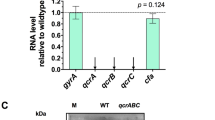Abstract
Escherichia coli can use dimethyl sulfoxide (DMSO) as an electron acceptor during anaerobic growth on the oxidizable substrate, glycerol. During growth, the DMSO is reduced to dimethyl sulfide (DMS). For the reduction of DMSO, NADH, formate, lactate, reduced benzyl viologen, reduced methyl viologen, and dithionite can serve as electron donors. The terminal reductase and the dehydrogenases linking the various electron donors to the electron transport chain were found to be membrane bound. Chlorate-resistant mutants (chl) were unable to grow and reduce DMSO. However, in the case of thechlD mutant, growth and DMSO reduction can be restored by growth in the presence of high concentrations of molybdate. Mutants ofE. coli blocked in menaquinone (vitamin K2) biosynthesis—menB, menC, andmenD—were unable to grow with DMSO as an electron acceptor, even though the terminal reductase is present in these mutants. Both growth and DMSO reduction could be restored in these mutants by growth in the presence of the menaquinone intermediates,o-succinylbenzoate and 1,4-dihydroxy-2-naphthoate, depending on the metabolic block of the mutant. Thus menaquinone is involved in electron transport during DMSO reduction.
Similar content being viewed by others
Literature Cited
Barrett EL, Kwan HS (1985) Bacterial reduction of trimethylamine oxide. Annu Rev Microbiol 39:131–149
Bentley R, Meganathan R (1987) Biosynthesis of the isoprenoid quinones ubiquinone and menaquinone. In: Neidhardt FC, Ingraham JL, Low KB, Magasanik B, Schaechter M, Umbarger HE (eds)Escherichia coli andSalmonella typhimurium cellular and molecular biology, vol 1. Washington, DC: American Society for Microbiology, pp 512–520
Bilous PT, Weiner JH (1985) Dimethyl sulfoxide reductase activity by anaerobically grownEscherichia coli HB 101. J Bacteriol 162:1151–1155
Biolous PT, Weiner JH (1988) Molecular cloning and expression of theEscherichia coli dimethyl sulfoxide reductase operon. J Bacteriol 170:1511–1518
Cotter PA, Gunsalus RP (1989) Oxygen, nitrate, and molybdenum regulation ofdmsABC gene expression inEscherichia coli. J Bacteriol 171:3817–3823
Cox JC, Knight R (1981) Trimethylamine N-oxide (TMAO) reductase activity in chlorate-resistant or respiration-deficient mutants ofEscherichia coli. FEMS Microbiol Lett 12:249–252
Ingledew WJ, Poole RK (1984) The respiratory chains ofEscherichia coli. Microbiol Rev 48:222–271
Kwan HS, Barrett EL (1983) Roles of menaquinone and the two trimethylamine oxide (TMAO) reductases in TMAO respiration inSalmonella typhimurium: Mu d(Aprlac) insertion mutations inmen andtor. J Bacteriol 155:1147–1155
Lambdon PR, Guest JR (1976) Mutants ofEscherichia coli K12 unable to use fumarate as an electron acceptor. J Gen Microbiol 97:145–160
Lowry OH, Rosebrough NJ, Farr AL, Randall RJ (1951) Protein messurement with Folin phenol reagent. J Biol Chem 193:265–275
Meganathan R (1984) Inability ofmen mutants ofEscherichia coli to use trimethylamine-N-oxide as an electron acceptor. FEMS Microbiol Lett 24:57–62
Meganathan R, Miguel L (1987) Dimethyl sulphoxide respiration inProteus mirabilis. Microbios 51:191–201
Meganathan R, Schrementi J (1987) Tetrahydrothiophene 1-oxide as an electron acceptor forEscherichia coli. J Bacteriol 169:2662–2665
Miguel L, Meganathan R (1987) Requirements for dimethyl sulphoxide reduction inEscherichia coli. Abstracts, Annual Meeting of the American Society for Microbiology, 1987:222
Pascal M-C, Burini J-F, Chippaux M (1984) Regulation of the trimethylamine N-oxide (TMAO) reductase inEscherichia coli: analysis oftor::Mudl operon fusion. Mol Gen Genet 195:351–355
Sakaguchi M, Kawai A (1977) Electron donors and carriers for the reduction of trimethylamine N-oxide inEscherichia coli. Bull Japan Soc Scient Fish 43:437–442
Shimokawa O, Ishimoto M (1979) Purification and some properties of inducible tertiary amine N-oxide reductase fromEscherichia coli. J Biochem 86:1709–1717
Silvestro A, Pommier J, Giordano G (1988) The inducible trimethylamine N-oxide reductase ofEscherichia coli K12: biochemical and immunological studies. Biochim Biophys Acta 954:1–13
Styrvold OB, Strom AR (1984) dimethylsulfoxide and trimethylamine oxide respiration ofProteus vulgaris. Arch Microbiol 140:74–78
Taber H (1979) Functions of vitamin K2 in microorganisms. In: Suttie JW (ed) vitamin K metabolism and vitamin K-dependent proteins. Baltimore: University Park Press, pp 177–187
Violet M, Medani C-L, Giordano G (1985) Trimethylamine N-oxide (TMAO) reductases fromEscherichia coli K-12. FEMS Microbiol Lett 27:85–91
Weiner JH, Maclssac DP, Bishop, RE, Bilous PT (1988) Purification and properties ofEscherichia coli dimethyl sulfoxide reductase, an iron-sulfur molybdoenzyme with broad substrate specifity. J Bacteriol 170:1505–1510
Yamamoto I, Okubo N, Ishimoto M (1986) Further characterization of trimethylamine N-oxide reductase fromEscherichia coli, a molybdoprotein. J Biochem 99:1773–1779
Yamamoto I, Hinakura M, Seki S, Seki Y, Kondo H (1990) Anaerobic induction of trimethylamine N-oxide reductase and cytochromes by dimethyl sulfoxide inEscherichia coli. Curr Microbiol 20:245–249
Zinder SH, Brock TD (1978) Dimethyl sulphoxide reduction by microorganisms. J Gen Microbiol 105:335–342
Author information
Authors and Affiliations
Rights and permissions
About this article
Cite this article
Miguel, L., Meganthan, R. Electron donors and the quinone involved in dimethyl sulfoxide reduction inEscherichia coli . Current Microbiology 22, 109–115 (1991). https://doi.org/10.1007/BF02105385
Issue Date:
DOI: https://doi.org/10.1007/BF02105385




